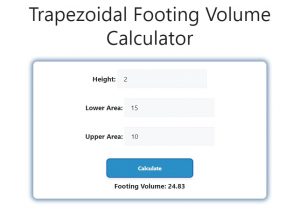About Trapezoidal Footing Volume Calculator (Formula)
The Trapezoidal Footing Volume Calculator is an essential tool for engineers and construction professionals involved in foundation design. Trapezoidal footings are commonly used in building projects due to their ability to distribute loads over a larger area, providing stability and support. Understanding how to accurately calculate the volume of these footings is crucial for ensuring structural integrity and optimizing material usage.
Formula
The formula for calculating the volume of a trapezoidal footing is: V = H/3 * (A1 + A2 + (SQRT(A1 * A2))). In this formula, V represents the volume, H is the height of the footing, A1 is the area of the top surface, A2 is the area of the bottom surface, and SQRT denotes the square root.
How to Use
Using the Trapezoidal Footing Volume Calculator involves a few straightforward steps:
- Measure the Areas: Begin by measuring the areas of the top and bottom surfaces of the trapezoidal footing (A1 and A2). Ensure these measurements are in the same units.
- Determine the Height: Measure the height (H) of the trapezoidal footing from the top surface to the bottom surface.
- Input Values: Enter the values of A1, A2, and H into the calculator.
- Calculate Volume: Execute the calculation to determine the volume (V) of the trapezoidal footing. The calculator will apply the formula to provide you with the result.
Example
Suppose you have the following measurements for a trapezoidal footing:
- Area of the top surface (A1): 10 m²
- Area of the bottom surface (A2): 15 m²
- Height (H): 2 m
Using the formula:
V = H/3 * (A1 + A2 + (SQRT(A1 * A2)))
V = 2/3 * (10 + 15 + (SQRT(10 * 15)))
V = 2/3 * (25 + (SQRT(150)))
V = 2/3 * (25 + 12.25)
V = 2/3 * 37.25
V ≈ 24.83 m³
Thus, the volume of the trapezoidal footing is approximately 24.83 cubic meters.

FAQs
1. What is a trapezoidal footing?
A trapezoidal footing is a type of foundation that has a trapezoidal shape, providing stability by distributing loads over a larger area.
2. Why is the volume of a trapezoidal footing important?
Calculating the volume is essential for estimating the amount of concrete needed and ensuring proper load distribution.
3. What units should I use for measurements?
Measurements can be taken in any consistent unit system, such as meters or feet, but all measurements must be in the same units.
4. Can I use the calculator for different shapes?
This calculator is specifically designed for trapezoidal footings. Different shapes will require different formulas.
5. How accurate do my measurements need to be?
Measurements should be as accurate as possible to ensure precise volume calculations.
6. What if my areas are not in square meters?
Ensure that all area measurements are converted to the same unit (e.g., square meters) before inputting them into the calculator.
7. What is the significance of the height in the calculation?
The height affects the overall volume of the footing, influencing how much concrete is needed for construction.
8. Can I calculate the volume manually?
Yes, you can calculate the volume manually using the provided formula, but using a calculator is more convenient.
9. Are trapezoidal footings suitable for all types of structures?
Trapezoidal footings are versatile and can be used for various structures, but it’s essential to consult with a structural engineer for specific applications.
10. How does the trapezoidal shape improve stability?
The trapezoidal shape allows for better load distribution, reducing the risk of settling or failure under heavy loads.
11. What factors should I consider when designing footings?
Soil type, load requirements, and environmental conditions are critical factors to consider in footing design.
12. Can the calculator help with other types of foundations?
No, this calculator is tailored for trapezoidal footings specifically. Other foundation types require different calculations.
13. How can I ensure proper drainage with my footings?
Incorporate drainage solutions in your design, such as drainage pipes or gravel backfill, to prevent water accumulation around footings.
14. What materials are typically used for trapezoidal footings?
Concrete is the most commonly used material due to its strength and durability.
15. Is professional assistance necessary for footing design?
It is advisable to consult a structural engineer to ensure that the design meets safety and building code requirements.
16. What is the typical depth for footings?
The depth of footings varies based on load requirements and soil conditions, but they generally range from 1 to 2 meters.
17. How can soil conditions affect footing design?
Soil type and load-bearing capacity significantly influence the size and shape of footings required for stability.
18. Can weather conditions affect footing installation?
Yes, adverse weather conditions can impact the curing process of concrete and overall footing stability.
19. How long does concrete take to cure fully?
Concrete typically takes 28 days to cure fully, but initial strength can be achieved in a few days.
20. What maintenance is required for footings?
Regular inspections should be conducted to identify signs of settling or damage, ensuring the longevity of the foundation.
Conclusion
The Trapezoidal Footing Volume Calculator is a valuable tool for engineers and construction professionals. Accurately calculating the volume of trapezoidal footings is essential for effective foundation design, ensuring safety and stability in construction projects. By following the outlined steps and understanding the significance of the measurements involved, professionals can optimize their material usage and enhance the structural integrity of their builds.